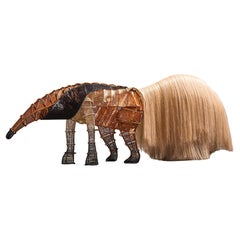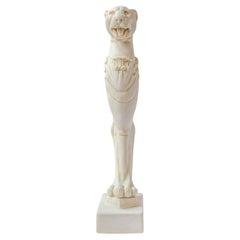Hechizoo Animal Sculptures
4
to
4
4
4
4
4
Height
to
Width
to
4
4
1
4
4
11
119
102
74
73
Creator: Hechizoo
Salento Armadillo
By Hechizoo
Located in New York, NY
"Salento Armadillo" by Hechizoo, is a captivating cast bronze sculpture that seamlessly blends the organic form of an armadillo with one of the studio's signature rug pattern innovat...
Category
2010s Colombian Hechizoo Animal Sculptures
Materials
Bronze
Arabian Nights Jaguar
By Hechizoo
Located in New York, NY
The Arabian Nights Jaguar by Hechizoo, a black cast bronze sculpture that captures the essence of power, grace, and mystique embodied by the enigmatic jaguar. This remarkable piece, ...
Category
2010s Colombian Hechizoo Animal Sculptures
Materials
Bronze
Inga Iguana
By Hechizoo
Located in New York, NY
The "Inga Iguana," a remarkable creation by Hechizoo that transcends traditional artistic boundaries. This black cast bronze iguana is a fusion of meticulous craftsmanship and imagin...
Category
2010s Colombian Hechizoo Animal Sculptures
Materials
Bronze
Anteater
By Hechizoo
Located in New York, NY
"Anteater," is a magnificent sculpture by Hechizoo that embodies the intersection of artistic mastery and cultural innovation. Rooted in the recent exhibition "Original Sin" and guid...
Category
2010s Colombian Hechizoo Animal Sculptures
Materials
Metal, Bronze, Copper
Related Items
Travertine Animals; Elephant, Anteater, Hippo, & Rhino, Flli Mannelli for Raymor
By Fratelli Mannelli, Raymor, Fratelli Manelli
Located in Miami, FL
Midcentury collection of animals rendered in carved travertine designed by Flli Mannelli for Raymor, Italy, 1960s,
Category
Mid-20th Century Italian Mid-Century Modern Hechizoo Animal Sculptures
Materials
Travertine
H 2 in W 3.25 in D 0.75 in
Jaguar Statue Made with Compressed Marble Powder 'Ephesus Museum'
By LAGU
Located in İSTANBUL, TR
The ancient city of Ephesus, which dates back to 6000 BC, has been a coastal city belonging to the Romans, Greeks and Turks at different times. The city is known as the place where C...
Category
2010s Turkish Classical Greek Hechizoo Animal Sculptures
Materials
Statuary Marble
Rene Lalique Boxed Large Frosted Art Glass Jaguar Cat
Located in Bishop's Stortford, Hertfordshire
A large and exceptional Lalique art glass figure of a Jaguar cat in clear and frosted glass dating from 1999. The prowling Jaguar has moulded markings to its body with a etched signa...
Category
1990s French Hechizoo Animal Sculptures
Materials
Art Glass
Contemporary Ceramic Gold White Parrot Decoration Figure, Netherlands, 2020
Located in Madrid, ES
Ceramic parrot figure in white and gold finish.
Category
2010s Dutch Modern Hechizoo Animal Sculptures
Materials
Ceramic
H 13.78 in W 4.34 in D 6.3 in
Ancient South Arabian Alabaster Inscription
Located in London, GB
South Arabian Alabaster Inscription
Calcite Alabaster
circa 1st century A.D.
‘’Consequently, neither white marble of Paros nor any other stone which men admire can be compared with the precious stones of Arabia, since their whiteness is most brilliant, their weight the heaviest, and their smoothness leaves no room for other stones to surpass them.’’
- Diodorus Siculus, Library of History, Book II, 52.9
This inscription, finely worked on an alabaster tablet, is a remarkably well preserved example of Ancient South Arabian script, with its distinct bold, angular forms, written in the Qatabanic dialect - that is, the dialect spoken by the people of the kingdom of Qataban, which ruled much of modern day Yemen from the 7th Century B.C. to the 2nd Century A.D. The text, which reads: ‘[... ...]sa?d and Ma?add?i- / (of the lineage) of Hawfa- / She entrusted Anb- / against any malfeasance (which would remove it) from its place’ - indicates that it likely served to commemorate a temple offering. The quality of the script, incised so neatly into the surface of the alabaster, tells us that this piece was commissioned by somebody of considerable wealth and prestige, employing a scribe of equally considerable expertise.
South Arabia was known throughout the ancient world for its incredible wealth - so much so that the Romans termed the region ‘Arabia Felix’ - literally, ‘Happy, or Fortunate, Arabia.’ That wealth was built largely on the trade of spices and incense, in which the Kingdom of Qataban played a major part. According to Pliny the Elder, this was the sole country through which frankincense could be exported, first being collected in the city of Shabwa, on the South Arabian coast, and from there travelling by camel up to Gaza, to be shipped all across the Mediterranean - not only that, but all growers of myrrh across Arabia were required to give a quarter of their yield to the king of the Qatabanians. As such, the kingdom became exceedingly rich and powerful, and Pliny goes on to tell us that ‘The nations of the Larendani and the Catabani, and the Gebanitæ [...] occupy a great number of towns, the largest of which are Nagia, and Thomna (the capital of Qataban) with sixty-five temples, a number which fully bespeaks its size.’ Because of the nature of its exports, frankincense in particular - the ‘sweat of of the gods’ according to the Egyptian Book of the Dead, and perhaps most famous as one of the three gifts brought to the newborn Christ - being closely associated with the divine, South Arabia’s reputation in antiquity was as a mysterious, almost sacred, and - crucially - extraordinarily wealthy region, at the very edge of the known world; in the words of Herodotus: ‘’Enough of marvels, and yet the land of Arabia gives off a scent as sweet as if divine.’’
This inscription invokes the protection of god Anbay, the judge-oracle of the chief god ‘Amm, who he served as an attendant. Much of what we know of the religious life of the ancient South Arabians comes to us from early Islamic texts, describing what is known in Islamic scholarship as ‘Jahiliyyah’ - the age before the advent of Islam in Arabia. What comes across in much of these texts is that these religious practices placed a great deal of emphasis on sacred stones, perhaps linked to the brilliance of the alabaster which is local to the region, and which a great many of the cult-objects produced in this time are made from. Hisham ibn-Al-Kalbi’s Book of Idols records: ‘’The Arabs were passionately fond of worshipping idols [...] Whenever a traveller stopped at a place or station in order to rest or spend the night, he would select for himself four stones, pick out the finest among them and adopt it as his god, and use the remaining three as supports for his cooking-pot.’’
This inscription was once in the collection of the intrepid British-Australian travel...
Category
15th Century and Earlier Yemeni Antique Hechizoo Animal Sculptures
Materials
Alabaster
21st Century Ettore Sottsas Demistella Console in Briar, Polychrome Marble, Wood
By Ettore Sottsass
Located in massa, IT
Polychrome marble console designed by Ettore Sottsass.
Description: Console with top in polychrome marble, wood, Macchia Vecchia Marble, Marquinia Bla...
Category
21st Century and Contemporary Italian Modern Hechizoo Animal Sculptures
Materials
Marble
H 31.5 in W 14.97 in D 23.63 in
Steel Bottle Opener by Gentner Design
By Christopher Gentner
Located in Geneve, CH
Darkned Brass Bottle Opener by Gentner Design
Dimensions: D 14 x W 1.9 x H 1.9 cm
Materials: stainless steel
Strong in form and heavy in weight, the bottle openers are elegant in th...
Category
2010s American Post-Modern Hechizoo Animal Sculptures
Materials
Stainless Steel
Spanish Wicker Donkey
Located in Antwerp, BE
A decorative wicker donkey from Spain, circa 1950s.An artisan piece with a rustic, Mediterranean feel. Wicker side baskets evoke goods sold at a market o...
Category
Mid-20th Century Spanish Country Hechizoo Animal Sculptures
Materials
Wicker
Large Mid-Century Owl Sculpture
Located in Antwerp, BE
Rare and highly decorative, 1970's owl sculpture, signature illegible .
This stunning barn owl will look great on any mid-century design piece of furniture. It is beautifully made an...
Category
Mid-20th Century European Mid-Century Modern Hechizoo Animal Sculptures
Materials
Ceramic
Supreme Hand Painted Monumental Porcelain Jaguar Sculpture, Spring Summer 2023
By Supreme
Located in Brooklyn, NY
Supreme hand painted Monumental Porcelain Jaguar Sculpture, Spring Summer 2023.
34" ceramic hand painted jaguar with logo on side. Made in Italy exc...
Category
21st Century and Contemporary Italian Hechizoo Animal Sculptures
Materials
Ceramic, Porcelain
H 34 in W 16 in D 20 in
Bronze Tabletop Vintage Duck Statuette, Lost Wax with Fine Details
Located in Yonkers, NY
This vintage bronze duck tabletop statuette is a charming and intricately detailed piece, showcasing the exquisite craftsmanship of the lost wax process. The fine details on the feat...
Category
20th Century Hechizoo Animal Sculptures
Materials
Bronze
Ronzan “Stile” Jaguar Ceramic, 1950, Italy
Located in Milano, IT
Ronzan “stile” Jaguar ceramic, 1950, Italy.
Category
1950s Italian Other Vintage Hechizoo Animal Sculptures
Materials
Ceramic
Hechizoo animal sculptures for sale on 1stDibs.
Hechizoo animal sculptures are available for sale on 1stDibs. These distinctive items are frequently made of metal and are designed with extraordinary care. Prices for Hechizoo animal sculptures can differ depending upon size, time period and other attributes — on 1stDibs, these items begin at $1,290 and can go as high as $75,000, while a piece like these, on average, fetch $19,500.




